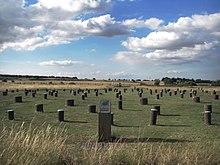Timber Circle
Timber Circles ( English for post circles ) are a group of monuments from the late Neolithic and early Bronze Age . They consist of upright stakes that form concentric circles. Some grounds are referred to as henge , although henges are stone circles with ring trenches. The shapes and sizes of the Timber Circles vary. The circles can also be eccentric ( Bleasdale Timber Circle ). Occasionally wood and stone are combined. Post circles are often part of a larger architecture and lie within other types of monument (e.g. Timber Circles at Henge Stanton Drew in Somerset ). Post- setting, like stone setting, the wooden equivalent of which they seem to represent, such as avenues as a double row to a circle ( Mount Pleasant , Poole Timber Circle and Conygar Hill Timber Circle in Dorset , The Sanctuary in Wiltshire ), while e.g. B. the Southern Circle of Durrington Walls (in Wiltshire) do not have this.
distribution
Timber Circles never survived as original structures because of the biodegradability of the wood. They are mostly only known from archaeological excavations, or because they were recognized by aerial photography ( Stoke Fields Farm ). The majority of them are found in England ( Bleasdale Timber Circle ), Scotland (Meldon Bridge) and Wales , but also in Ireland ( Knowth Timber Circle ) and Northern Ireland ( Timber Circle from Ballygawley ). One of the few Timber Circles that have been preserved in any way is the site on the Norfolk coast, referred to as Seahenge in allusion to Stonehenge . In Logabirum in Emsland in 1935, when the mound was removed, a not very carefully constructed, five-fold concentric circle made of 314 posts was exposed, the outer diameter of which was about 12.0 m.
description
The post holes often contain the stone packings that held the posts upright. It is estimated that a third of the post (tree trunk) was in the ground and two thirds was visible above ground. The formerly visible height of the post is deduced from the depth of the hole. Science is only beginning to understand how the wooden circles relate to the monuments of the late Neolithic. Presumably many of them stood in isolation in other Neolithic landscapes. Where the Timber Circles lie next to henges, menhirs or stone circles , there are a multitude of interpretations. One of the most difficult aspects is the chronological assignment.
In addition to the round specimens, there are some previously discovered D- or horseshoe-shaped post settings in the British Isles , whose equivalents in stone (e.g. Achavanich ) also exist. Wooden post horseshoes can be found, for example:
- in the Henge von Lugg in County Dublin in Ireland.
- in the Timber Circle of Ballygawley in Northern Ireland,
- in the henge of Arminghall in Norfolk in England,
- in the stone circle I of Machrie Moor on the Isle of Arran in Scotland.
Dating
Timber Circles are difficult to date. There is often little material left in the post holes. Evidence can be found in "weathering cones" in the post holes. These cones are believed to have been caused by the rotting of the posts. They leave a V-shaped indentation in which material such as ceramic or flint has accumulated. However, it is also conceivable that these introductions into the hole took place later or were attached for stabilization. Some researchers believe that people went to the memorial when the posts were rotten and deliberately put material into the cones of the post holes for religious reasons.
Irish Timber Circles
The 2006 to 2007 excavation of the Timber Circle of Ballygawley in County Tyrone in Northern Ireland yielded datable wood finds. According to the radiocarbon method, it was determined that the wooden structures were built in the middle of the 3rd millennium BC. And some parts were even older.
The archaeologists found several posts that apparently replaced an older row of pits. There was a trapoid porch on the side where the entrance was believed to be. The outer circle of wood was probably wickerwork , or there was a kind of palisade in the spaces so that the inner circle was invisible.
At Newgrange , similar to Knowth , two Timber Circles have been found near the main hill in recent digs. The eastern one consisted of five concentric rows of pits. The outer ring contained wooden posts. The next ring had a clay liner and was used to burn animal remains. The three inner rings of the pit were dug to accommodate the remains of animal sacrifices. Post holes with ceramics and flint chippings were found within the circle . The western circle consisted of concentric rows of post holes and pits that formed a circle 20 meters in diameter.
literature
- Alex M. Gibson: Stonehenge and Timber Circles . NPI Media Group 2000, ISBN 978-0-7524-1492-8
- Howard E. Kilbride-Jones: The excavation of a composite early iron age monument with "Henge" features at Lugg , Co. Dublin. Royal Irish Academy, 1950
Individual evidence
- ^ Charlie Watson: Seahenge: An Archaeological Conundrum . English Heritage, Swindon 2005, ISBN 1-85074-896-9 .
- ^ HE Kilbride-Jones: The Excavation of a Composite Early Iron Age Monument with "Henge" Features at Lugg, Co. Dublin In: Proceedings of the Royal Irish Academy. Section C: Archeology, Celtic Studies, History, Linguistics, Literature Vol. 53 (1950/1951), pp. 311-332
Web links
- Description and pictures (last accessed on March 8, 2014)

